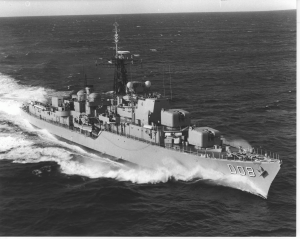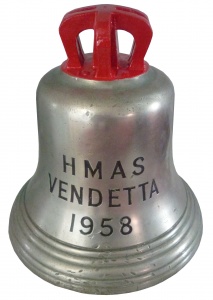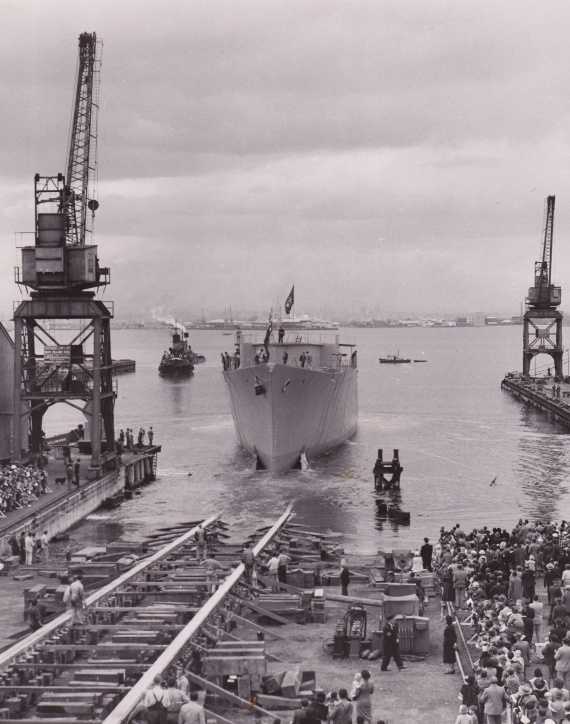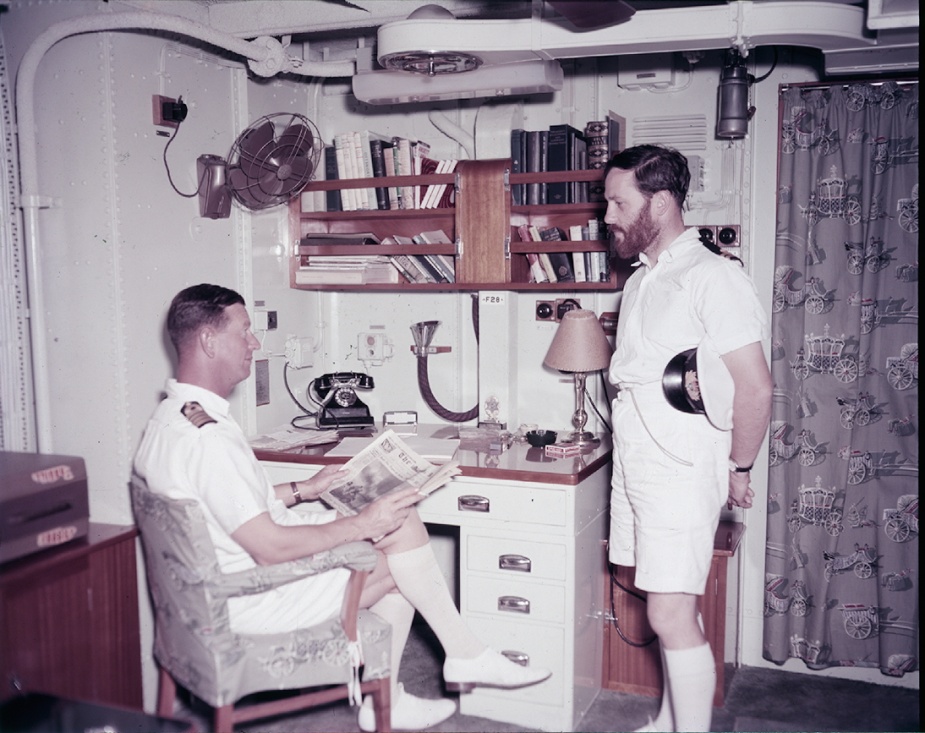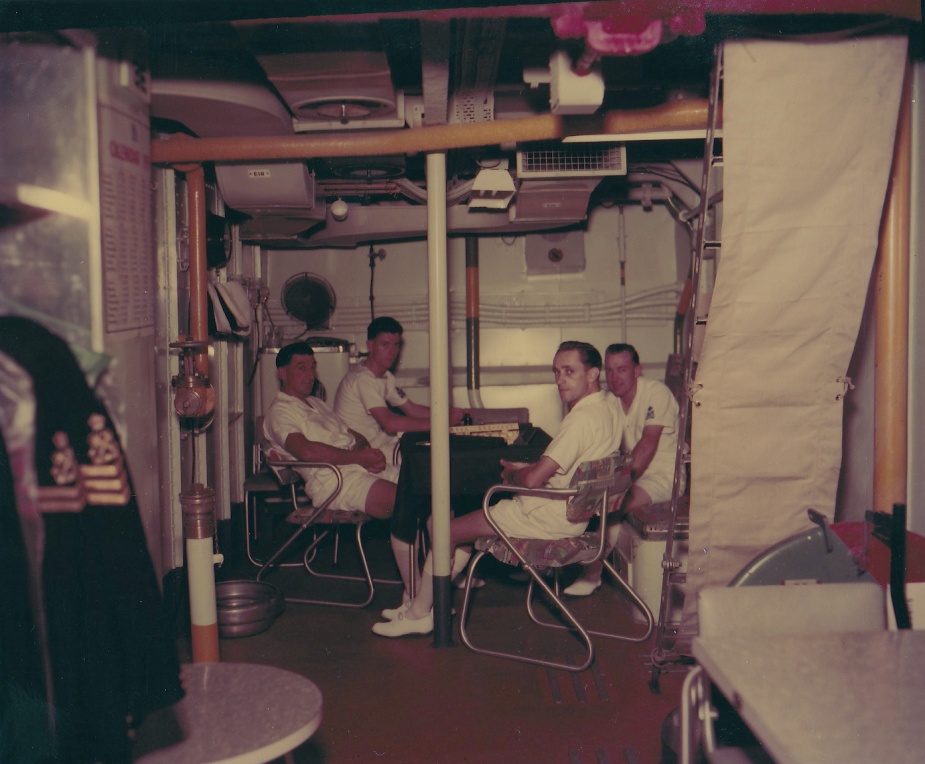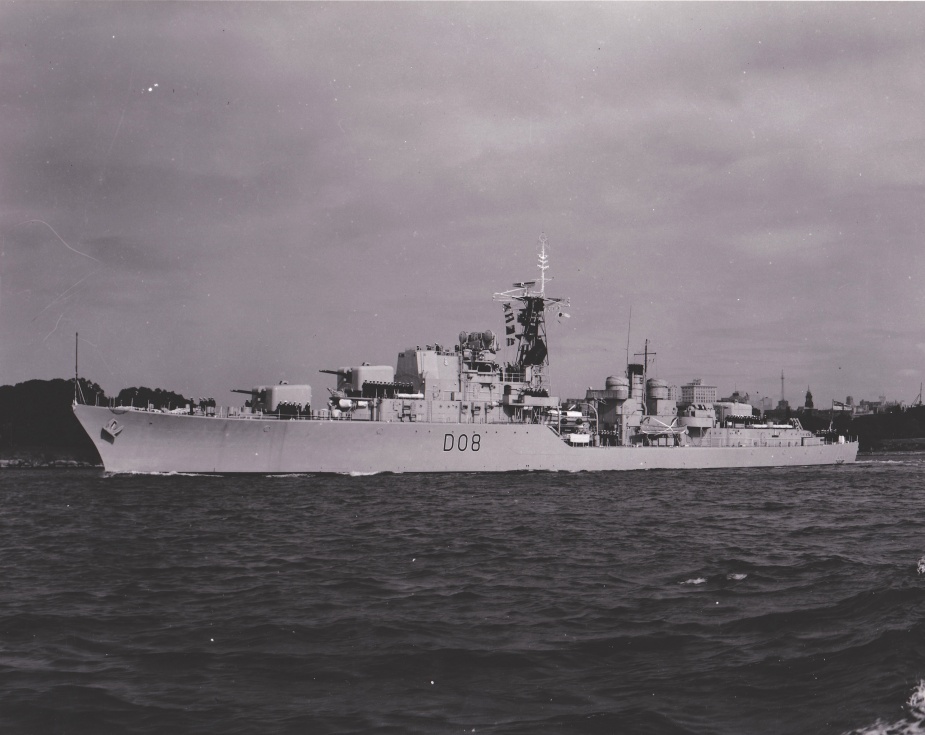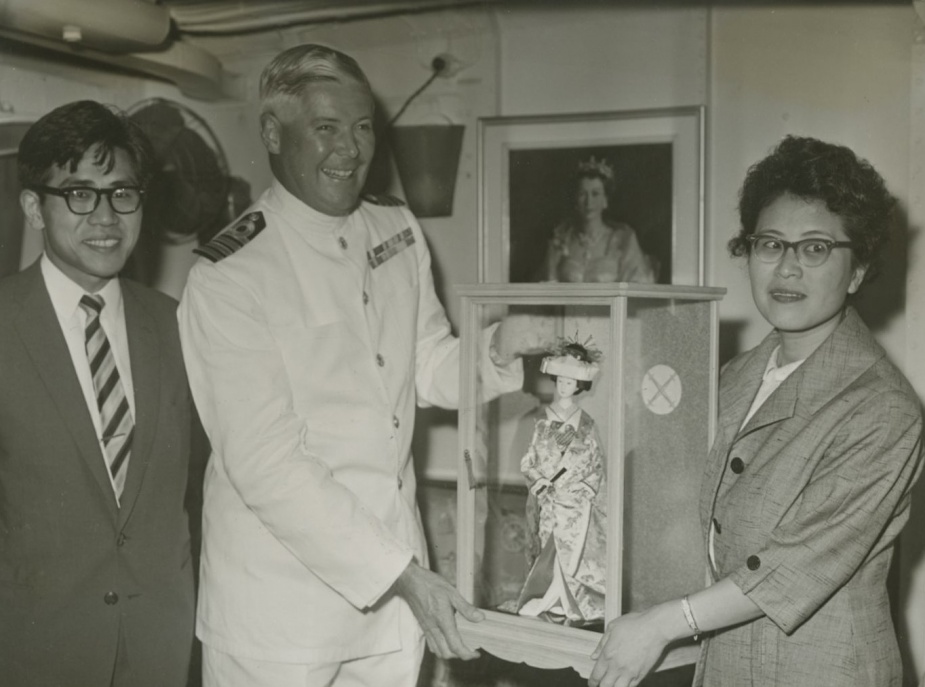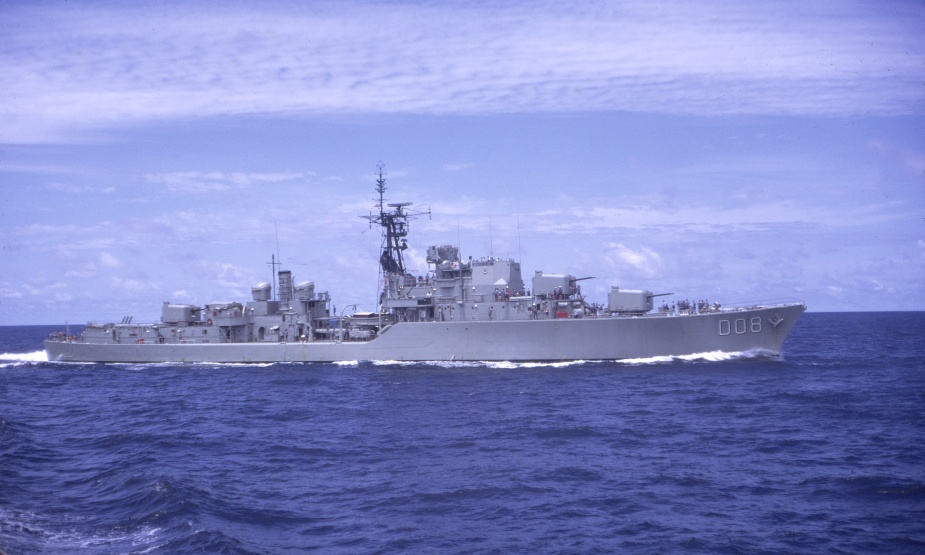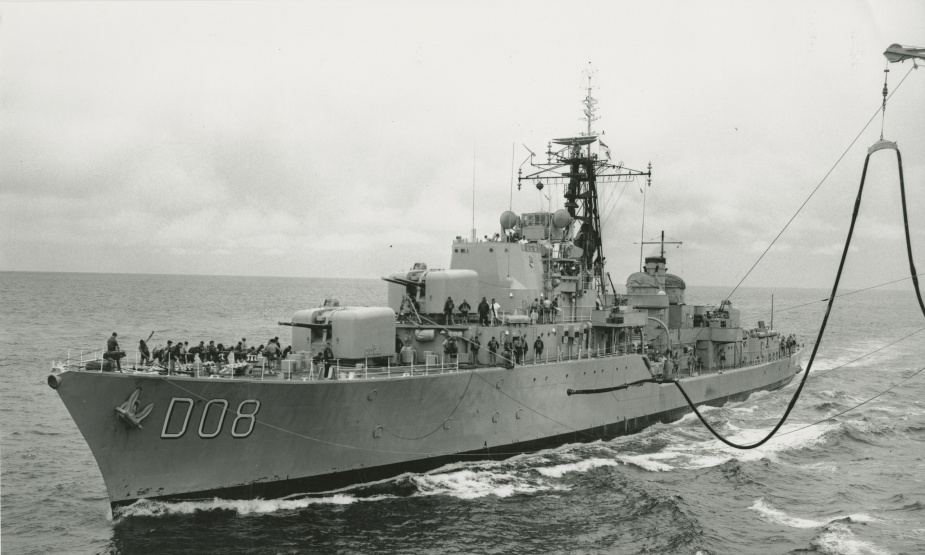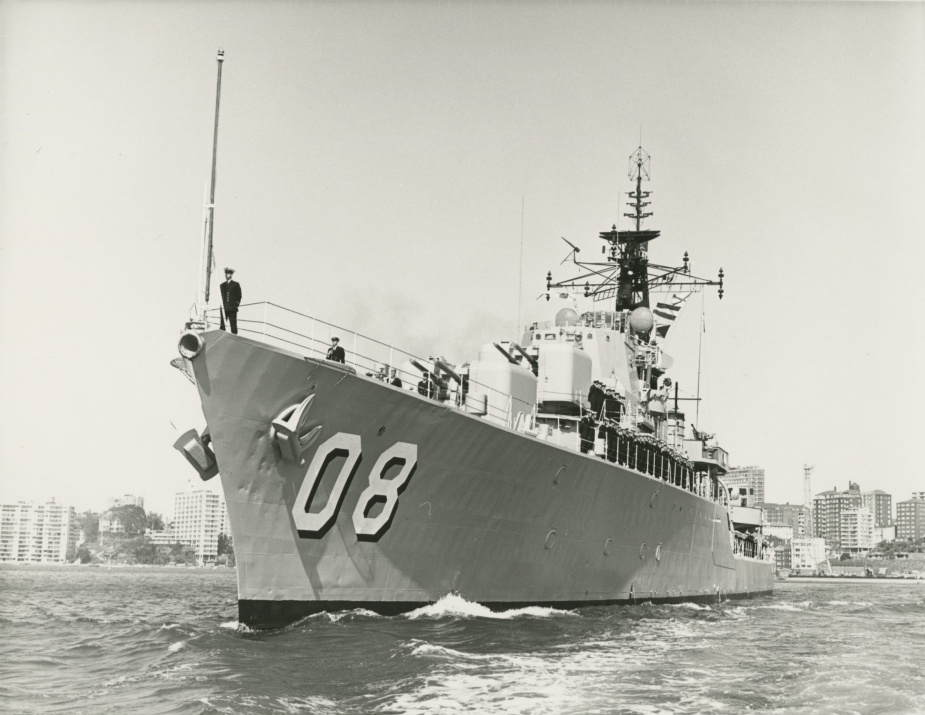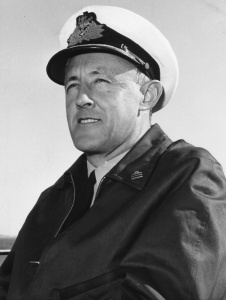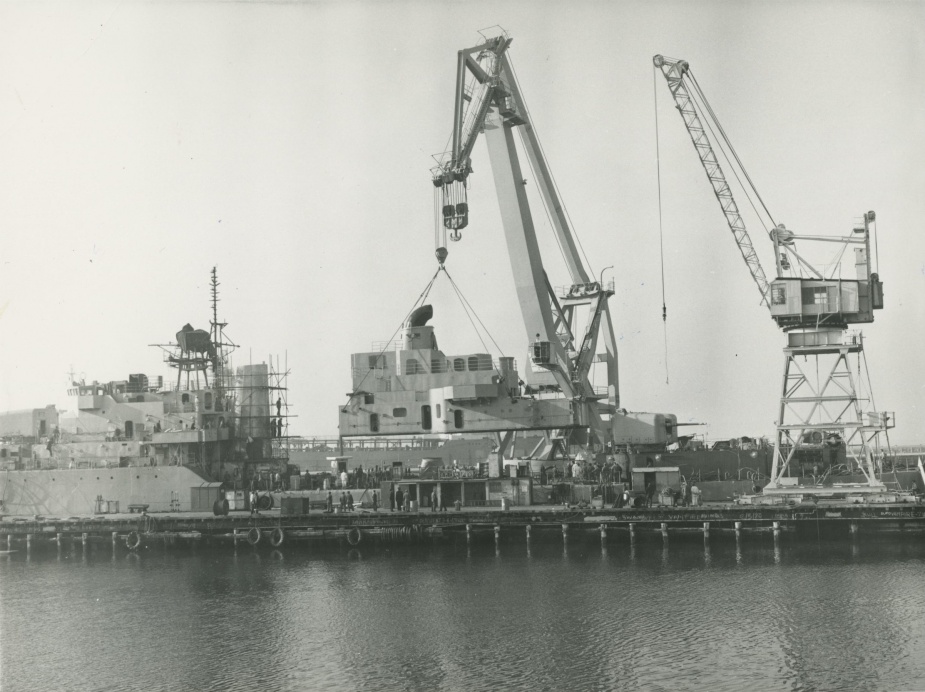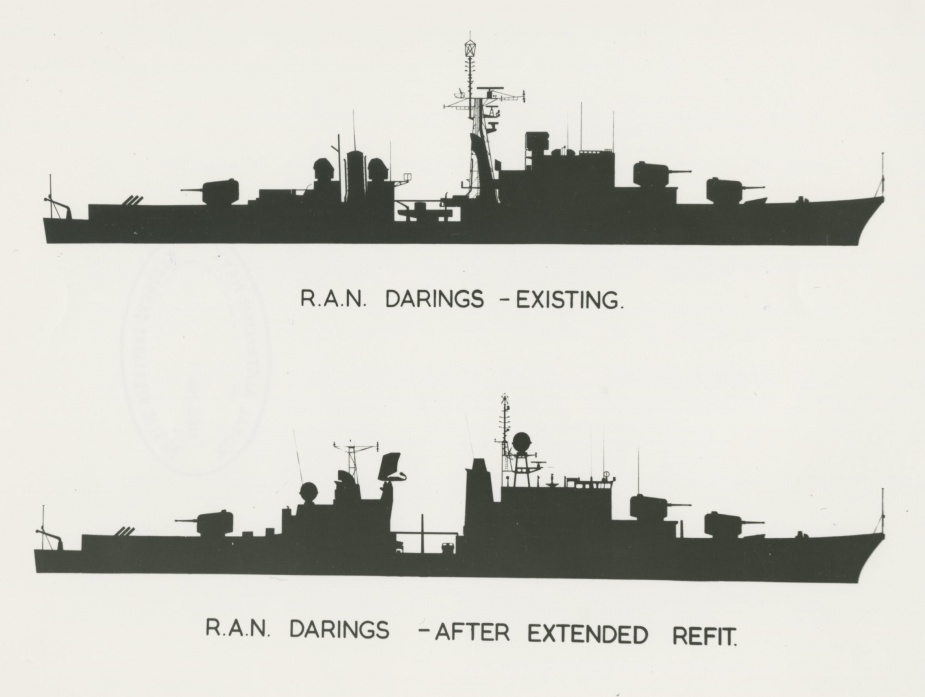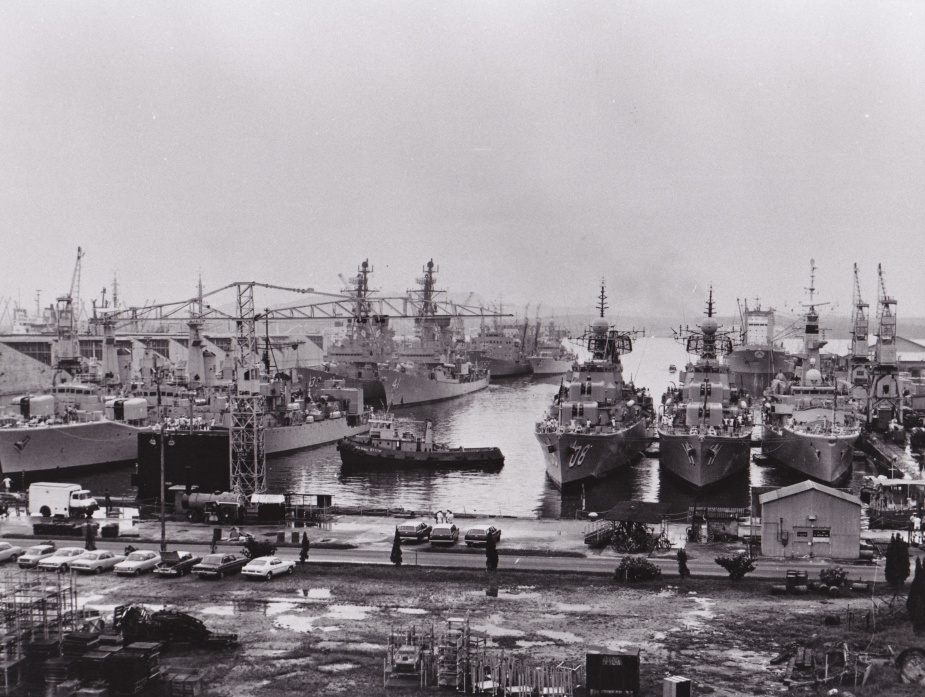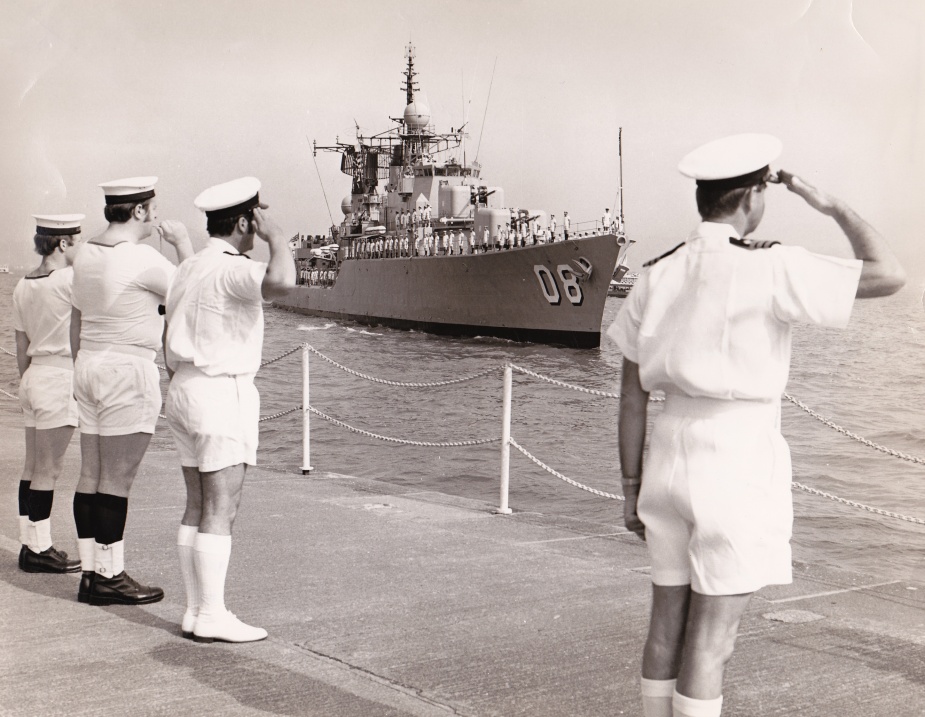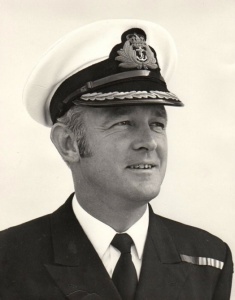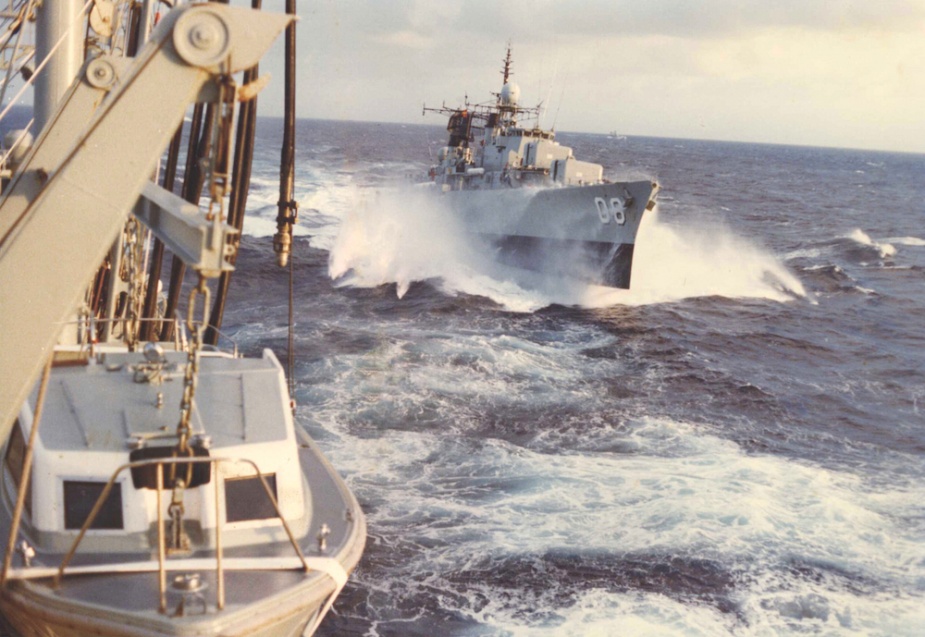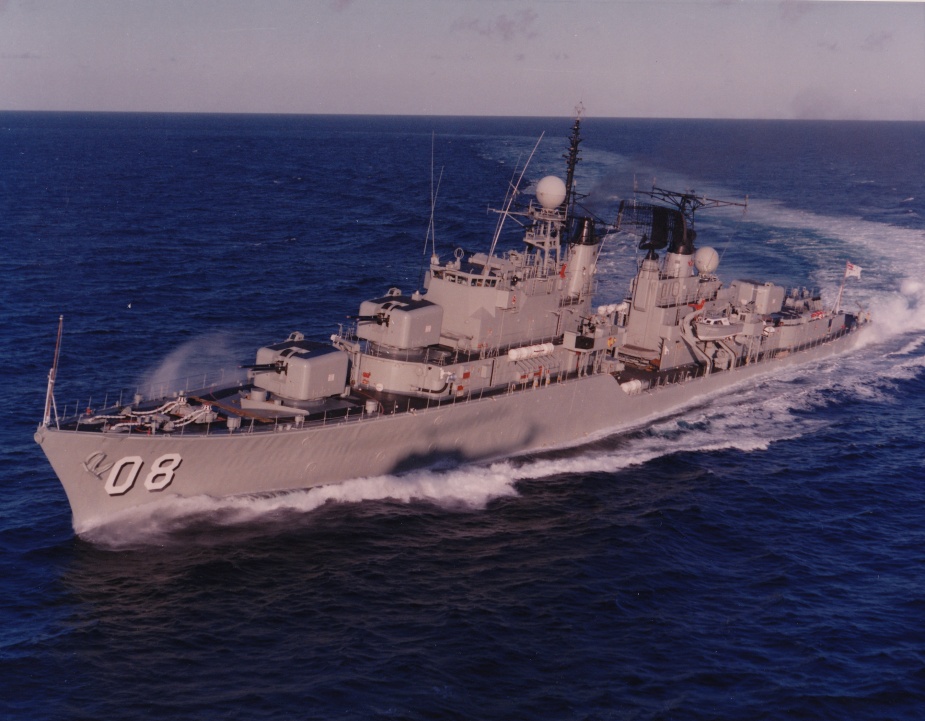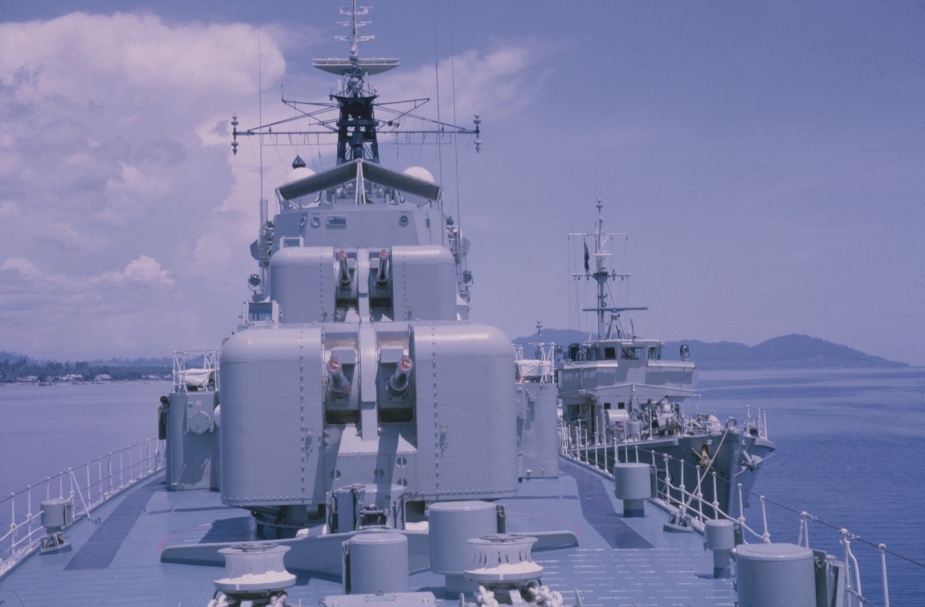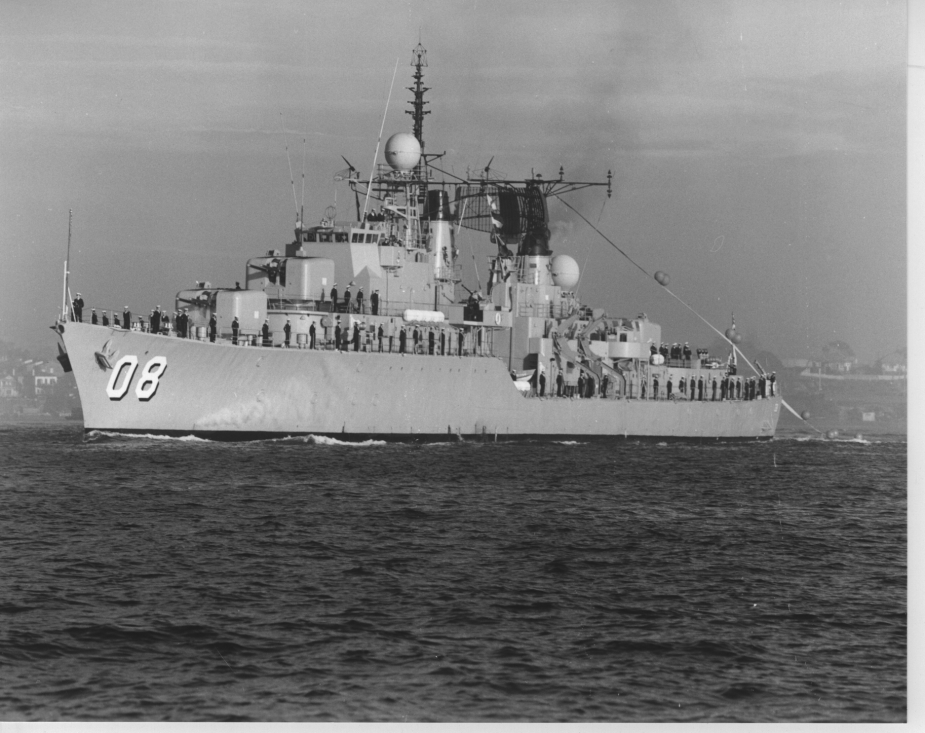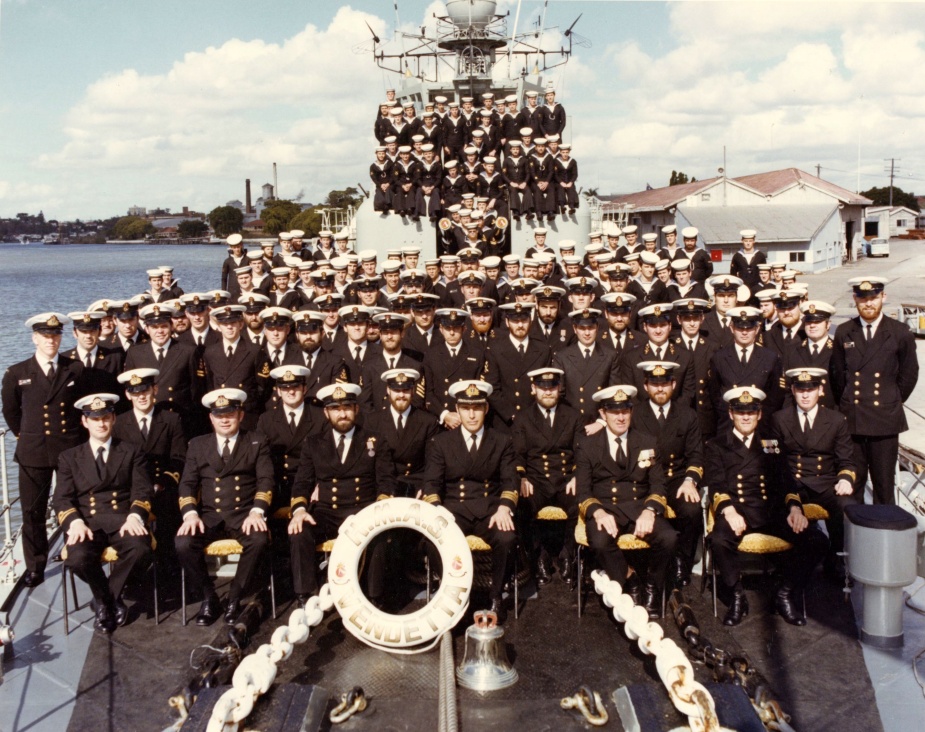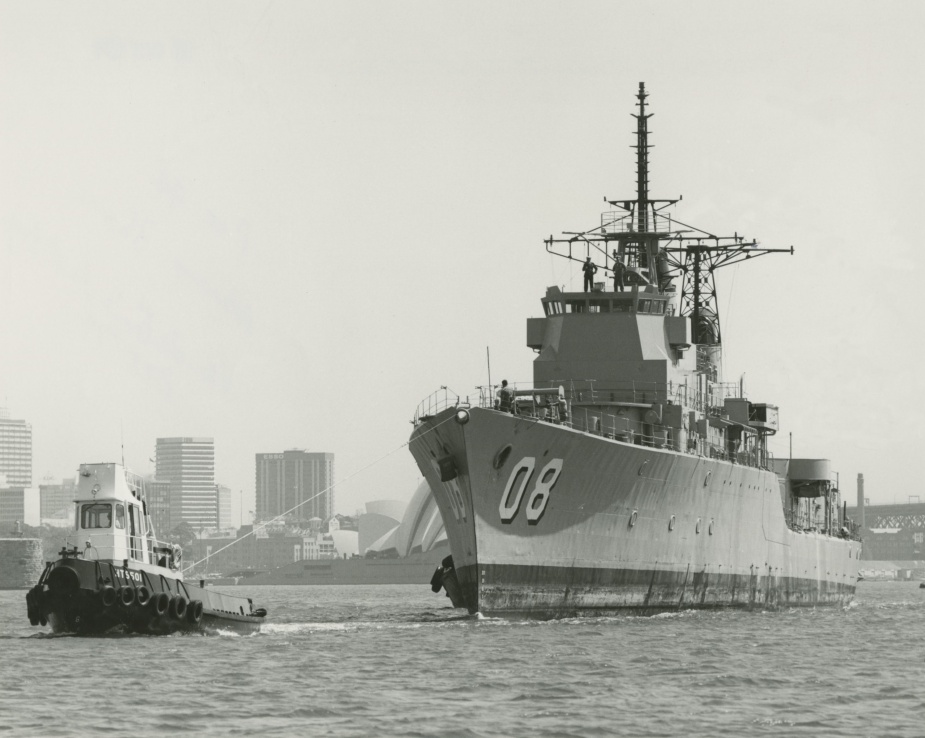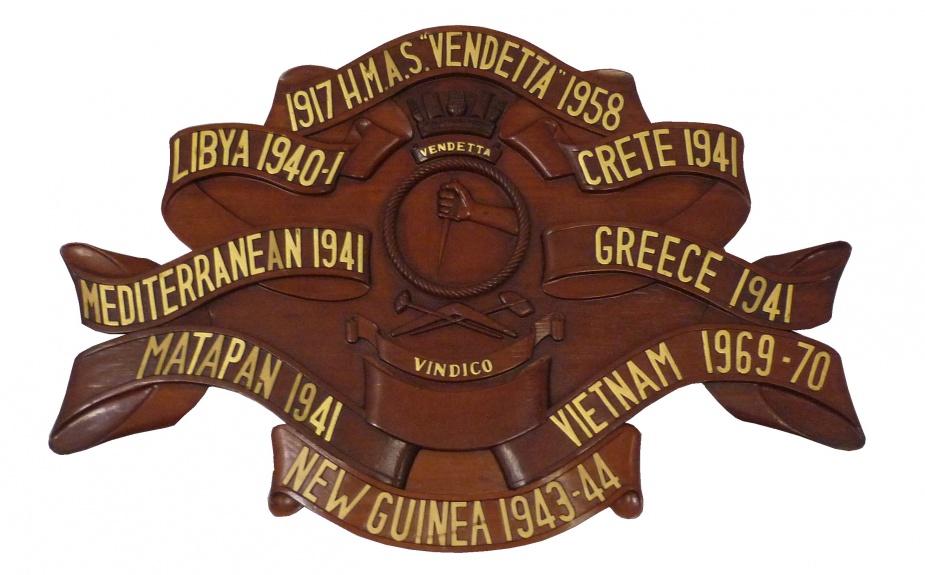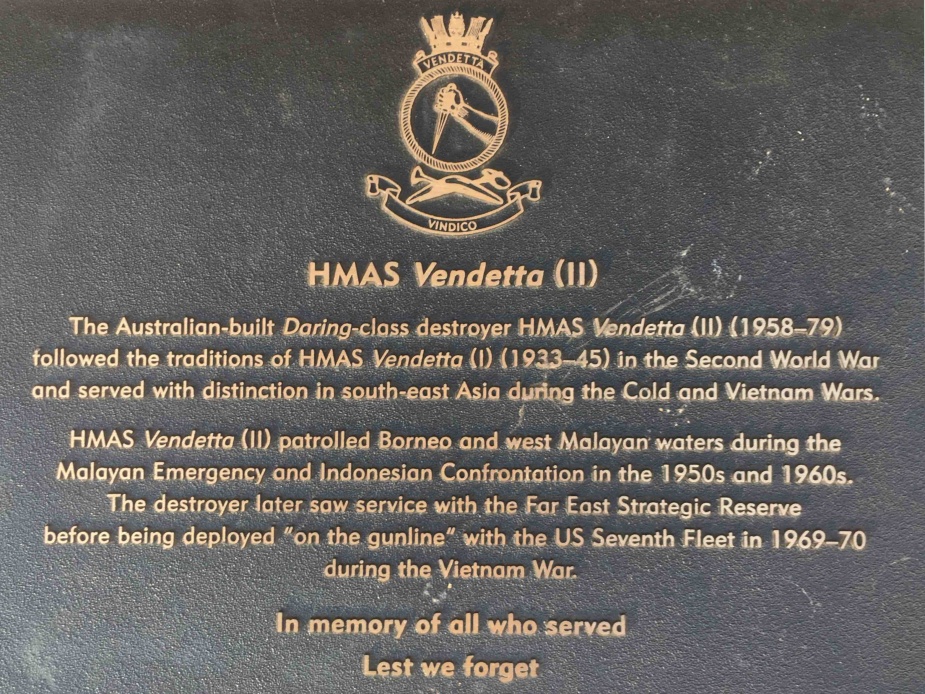HMAS Vendetta (II)
| Class |
Daring Class |
|---|---|
| Type |
Destroyer |
| Pennant |
D08 |
| Builder |
Williamstown Naval Dockyard, Melbourne |
| Laid Down |
4 July 1949 |
| Launched |
3 May 1954 |
| Launched by |
Mrs N Waller, widow of the late Captain HML Waller DSO RAN |
| Commissioned |
26 November 1958 |
| Decommissioned |
9 October 1979 |
| Dimensions & Displacement | |
| Displacement |
|
| Length | 388 feet 6 inches |
| Beam | 43 feet |
| Draught | 12 feet 3 inches |
| Performance | |
| Speed | 30 knots |
| Range | 3700 miles at 20 knots |
| Complement | |
| Crew | 320 |
| Propulsion | |
| Machinery |
|
| Horsepower | 54,000 |
| Armament | |
| Guns |
|
| Torpedoes | 5 x 21-inch torpedo tubes in a quintuple mount (removed by late 1960's) |
| Other Armament | 1 triple barreled Limbo anti-submarine mortar |
| Awards | |
| Inherited Battle Honours | |
| Battle Honours | |
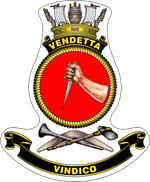
Advances in destroyer design in the United Kingdom during the mid to late 1940s resulted in the design of the Daring Class, originally described as light cruisers. The Australian built 'Daring' Class destroyers were similar to the Royal Navy vessels, but with modifications for Australian conditions.
The 'Darings' were designed and built as versatile, multi-purpose 'Gun Ships' with three separate weapon control systems to control the main and secondary armament. In the Naval Gunfire Support (NGS) mode for example, the main Gunnery Fire Control System was capable of providing very accurate and rapid fire to a range of nine nautical miles (18000 yards) in normal mode and in excess of ten nautical miles (20,000 yards) in extended range mode. At a rate of fire of 16 rounds per gun per minute, the Darings were capable of firing up to 100 x 4.5-inch shells per minute, with each standard high explosive shell weighing 56 lbs.
Four Darings were initially ordered for the Royal Australian Navy, although only three, Voyager (II), Vendetta and Vampire (II) were eventually completed. They were the first prefabricated all-welded ships to be built in Australia, and, between ordering and completion, the cost of each Daring increased from £2.6 million to £7 million.
Vendetta's career commenced with an accident even before she was commissioned. On 18 July 1958, while leaving her berth at Williamstown Dockyard, she rammed the dry dock caisson gates, and remained trapped there for five hours. Disaster was only narrowly averted. The frigate Quickmatch was under refit in the drydock, and if the dock gates had collapsed, she would have been swept aside by the torrent of water. Dockyard workers reacted swiftly to the emergency by flooding the dock, thus taking the pressure off the weakened caisson.
As could be expected the local newspapers had a field day, with Vendetta tagged 'The Wrong Way Warship.'
Vendetta, the second of the Australian Darings, commissioned at Melbourne on 26 November 1958 under the command of Captain Ronald J Robertson, DSC, RAN. After trials and workup the ship visited New Zealand in April 1959; New Guinea in June 1959 and Noumea in July 1959.
On 20 October 1959, the RAN's three Daring Class destroyers operated together for the first time, when Vendetta, Vampire (II) and Voyager (II) conducted a series of exercises and maneouvres in Jervis Bay area, the trio now forming the 9th Destroyer Squadron.
In November 1959, Vendetta departed for Singapore to begin an eight month deployment with the Commonwealth Strategic Reserve. The role of the Strategic Reserve was to deter communist aggression in South East Asia by defending Malaya and Singapore, and their sea lines of communication; and to assist in the maintenance of Malaya 's internal security through participation in operations against the Malayan Races Liberation Army, the armed component of the Malayan Communist Party. During this deployment Vendetta's readiness was tested with involvement in Exercises SEACUB and SEALION. She returned to Australian waters in mid-July 1960.
The Navy News of 9 September 1960 provides the following snippet. In January 1959, Vendetta's Petty Officers pitched in £1 each to buy a washing machine for their mess, to supplement the somewhat spartan facilities onboard.
Since then Vendetta has steamed 55,000 miles and visited 11 countries, mostly in South-East Asia. This kind of tropical traveling is 'murder' on clothes. What with greasy engine-room overalls and the fact that most of the 40 Petty Officers wash two sets of overalls and their whites each day, the machine was sometimes going 17 hours in the 24.
Following a mishap to the machine during a typhoon in the Gulf of Carpentaria, the Petty Officers approached Hoover for a replacement. This led to the company presenting a brand new washing machine to Vendetta's Petty Officers' Mess.
On 19 February 1961, the passenger ship Runic went aground on Middleton Reef off the Queensland coast during heavy weather. Vendetta was exercising in Jervis Bay at the time, and was ordered to proceed with all dispatch to render assistance. She reached Middleton Reef 20 hours later, and took off 12 passengers, returning them to Sydney.
In mid-March 1961, Vendetta departed Sydney for a second tour of duty with the Strategic Reserve. On this occasion, she sailed 'westabout' via Adelaide and Fremantle, before arriving in Singapore in early April. This was a busy deployment, including involvement in Exercise PONY EXPRESS, and official visits to ports as diverse as Hong Kong, Kobe, Manila and Penang Vendetta returned to Australia in October 1961 and again refitted at Williamstown Dockyard.
In March 1962, the ship once again deployed to Singapore for duty with the South-East Asian Treaty Organisation (SEATO), arriving in Singapore on 1 April. Many favourite ports were revisited plus new ones including Guam; and the ship was fully employed in a range of exercises.Vendetta returned to Australia in June, rendezvousing with HMA Ships Melbourne (II), Quiberon, Voyager (II) and Swan (II) in Cleveland Bay before sailing to Sydney for maintenance and leave.
In late July, Vendetta sailed for Noumea, accompanied by Quiberon. Due to a problem with port procedures, however, the crews could not actually visit the port. Anti-submarine exercises with HM Submarines Tabard and Tapir were scheduled during the return passage to Sydney. These were abandoned due to extremely heavy weather experienced when the two ships steamed through the eye of a cyclone off the Queensland coast. The remainder of 1962 was spent in exercises in Australian and New Zealand waters.
Exercise TUCKERBOX TWO was the focal point of all activity during the period 6-17 September, in an area stretching from the Coral Sea to Sydney. This involved a sizable proportion of the RAN with HMA Ships Melbourne (II), Vendetta, Vampire (II), Queenborough and Anzac (II), plus HM Ships Tiger, Caprice, Cassandra and Lock Killisport and several Royal Fleet Auxiliaries. Unfortunately the proposed Fleet Entry into Sydney Harbour on completion of the exercise had to be cancelled because of unfavourable weather.
In 1963, the defence problems in Australia's region of interest escalated when the new nation of Malaysia was proclaimed. Indonesia opposed this and embarked on a policy of 'confrontation', threatening to 'crush' the new nation. The Australian Government made plain its resolve that if Malaysia was subjected to invasion or subversive activity, then Australian military assistance would be added to that of Malaysia and Britain to defend the new nation. Royal Australian Navy warships in the Strategic Reserve based in Singapore were made available for naval patrol and escort operations to counter possible Indonesian attacks.
Following a four month refit in early 1963, in mid-July Vendetta sailed from Sydney, via Townsville and Darwin, for another term of duty 'up top' as an operational unit of the Commonwealth Strategic Reserve. This deployment saw the destroyer make 14 port visits in five foreign countries, culminating in Christmas and New Year in Hong Kong.
Vendetta returned to Australian waters in February 1964, and remained until June 1964, when she again deployed to South East Asia. During this deployment, the ship operated with Royal Navy and Royal Australian Navy units, and also conducted anti-Indonesian infiltration patrols in the Jason Bay-Mersing area. She took part in Exercise REEF KNOT before returning to Sydney in December 1964, for a seven month refit.
In late 1964, the United States was moving towards the commitment of American combat forces in South Vietnam. In December 1964, President Johnson and the Prime Minister of South Vietnam, asked for an Australian military contribution. This resulted in the commitment of an Australian infantry battalion, to be transported by RAN warships.
Vendetta commenced a further tour of duty in South East Asian waters in August 1965. This deployment commenced with Vendetta and her British-built sister Daring, Duchess, escorting the troop carrier, Sydney (III), to Cape St Jacques, South Vietnam via Manus Island and Subic Bay. Cape St Jacques is a strip of fast-running tidal water off the then US-controlled Vung Tau airbase. Once Sydney (III) and her escorts anchored off Cape St Jacques, it became the scene of non-stop activity for 48 hours as Sydney (III) disembarked her cargo of Australian troops and equipment.
On completion of this assignment, Vendetta sailed via Hong Kong for more operational patrols in the Malacca Straits area followed by the usual round of training activities. This included a period escorting the Royal Navy commando carrier HMS Albion. With Christmas fast approaching, Vendetta's crew were looking forward to spending Christmas Day alongside in Singapore, however, she sailed on 24 December and spent the Christmas period at sea patrolling the Malacca Strait. She returned to Sembewang on 29 December in time for the New Year. The destroyer returned to Sydney on 12 March 1966 for well earned leave and maintenance.
On Friday evening 20 May 1966, Vendetta was exercising in the Botany Bay area when a signal was received indicating that the dredge WD Atlas was in difficulties in gale force conditions south of Jervis Bay. Vendetta responded to the signal and battled her way through the mountainous seas to the search area. As the ship steamed towards the dredge, rising seas and high winds made conditions extremely difficult in her boiler rooms. During the early hours of Saturday 21 May, the ship was struck by a huge wave, and sea water poured into 'B' Boiler Room and Engine Room, resulting in flooded bilges, damage, and power failure. In addition, the weather conditions made it impossible to relieve the watchkeepers in the boiler room for some time.
Helicopters from the RAN air station HMAS Albatross rescued four exhausted survivors, while Vendetta carried on searching until late in the weekend, when all hope of finding further survivors had evaporated. The ship did, however, recover four bodies from the sea.
Following the mercy dash, the Naval Board approved the immediate promotion of Leading Engineer Mechanic WJ Robinson to Acting Petty Officer, as a result of his presence of mind and devotion to duty under arduous circumstances while in charge of Vendetta's 'B' Boiler Room.
In May 1966 Vendetta sailed once more for the Far East, escorting the troop carrier, Sydney (III), on that ship's fourth trip to Vietnam with Australian troops and equipment. Having completed that task, the destroyer returned to her home port for leave and maintenance in July
In early November Vendetta again played a role in a rescue operation, when she was involved in the refloating of the United States Navy Submarine, Tiru, which had run aground on Frederick Reef off the Queensland coast. When the tug on the scene was unable to free the submarine, Vendetta assisted in a tandem pull, and with their combined power, Tiru slipped off the reef.
Vendetta underwent a refit from February to August 1967, and from then until February 1968 was involved mainly in exercises in the East Australia area. In March 1968, the ship again deployed to South East Asian waters, returning to Australia in October 1968.
In early 1969, Vendetta underwent pre-refit trials and commenced a six month refit at Cockatoo Island Dockyard, Sydney, during which both propeller shafts were removed. In July, Vendetta's post-refit trials were disrupted by a small fire in cables in the Wardroom, and damage to the ship's generators. Trials and workup continued in August, and by early September, Vendetta was ready for attachment to the United States Navy's 7th Fleet in Vietnam waters.
On 15 September 1969, the ship departed Sydney and received a detailed handover from the guided missile destroyer (DDG), HMAS Brisbane (II), in Subic Bay on 26 September. This was the occasion for Captain Willis Brisbane (II)'s Commanding Officer to pass 'the weight' to Vendetta's Commanding Officer, Commander Johnston, symbolising the official handover of gunline duties. 'The weight' was fashioned from a pair of highly polished shell bases separated by a burnished metal rod. Around its base was inscribed the names of the RAN destroyers in the order of their deployment.
Vendetta was the first and only RAN Daring Class destroyer to go to war.
During the ensuing seven months, Vendetta performed credibly in a role for which she had been specifically designed - naval gunfire support. She proved herself to be a more than adequate replacement for a DDG on the 'gunline.' During her five tours totaling 93 days, Vendetta fired 13,295 4.5-inch shells, plus over 400 rounds of 40mm, steaming 21,000 nautical miles in the process.
Vendetta demonstrated the versatility of the Daring Class. Commander Johnston was able to ensure that, with six guns in three turrets, the ship always had at least one turret ready to fire at a moment's notice. Vendetta's readiness for action, quick response time and accurate fire won admiration and praise from those in 'harm's way' ashore and from US Navy 7th Fleet senior officers. In his official report, Commander Johnston noted that the gunnery system's:
...accuracy appeared to be beyond the wildest imagination of the maintainers and numerous spotting corrections of ten and twenty yards were received. The spotter's final summation of the gun accuracy has, I am afraid, inflated the gunnery officer's head beyond even the skills of Messrs Gieves [a well-known firm of military outfitters].
Despite spending Christmas and New Year on the 'gunline', Vendetta was able to make full preparations for Christmas festivities. A pudding described as being large enough for a full sized town was made, the ship's cafeterias were decorated, and the two visiting Navy chaplains arranged a busy schedule of church services for the ship's company. During the deployment, Vendetta and her ship's company spent well earned rest periods in Singapore, Hong Kong, Keelung and Koah Siung (Taiwan) and Subic Bay.
1970-1986
Vendetta was relieved by HMAS Hobart (II) at Subic Bay in late March 1970. Vendetta's cruise book mentions "the look of joy on the faces of the crew of Brisbane (II) as we steamed alongside in Subic Bay to relieve them. The same look was evident amongst crew members of Vendetta when Hobart (II) pulled alongside seven months later." Tongue in cheek, the cruise book mentions that "there is a buzz going around that Vendetta does not have any albatrosses or sea gulls in her wake but a 'Stork'". This was inspired by the fact that 21 members of the ship's company had new additions while the ship was deployed. Vendetta arrived back in Sydney on 11 April 1970.
After four months in home waters, Vendetta (II) again sailed for deployment to the Far East in September 1970. In late October 1970, Vendetta (II) again escorted HMAS Sydney (III) to Vung Tau, South Vietnam. The following months saw visits to Colombo, Bombay and Nagasaki, as well as the usual Far East ports. In April 1971, Vendetta (II) returned to Sydney 'west-about' and during the following months, the ship served in Australian and New Guinea waters. Vendetta (II) paid off on 29 September 1971 for 'half life' refit at Williamstown Naval Dockyard, Melbourne.
During the following 20 months, Vendetta underwent a $10 million refit, which incidentally was the same as her original cost some 12 years earlier. The ship was extensively modernised, with a new superstructure and an enclosed bridge, new navigation radar and long-range air early warning radar, action information centre upgraded, communications equipment renewed, messdecks improved, and gun turrets updated. Replacing the superstructure required the largest ever lift of an aluminium structure in an Australian dockyard, with the prefabricated structure weighing over 45 tons.
The ship's old electro-mechanical gunnery fire control system, the Flyplane System Mk 3 system, with its conglomeration of servos and gears, was replaced with a modern Dutch M22 digital fire control system. The modifications produced formidable gun ships, but increasing costs forced the deletion of proposed Ikara and Seacat systems, which meant that Vendetta (and Vampire (II)), were ill equipped to deal with the growing missile threat.
Following more than a year in dockyard hands, and completion of her post-refit trials and workups, Vendetta, now sporting a totally new silhouette, recommissioned at Williamstown on 2 May 1973. The Commissioning Warrant was read by her Commanding Officer, Commander AG Ferris, RAN.
On 26 July 1973, after an absence of almost two years, Vendetta returned to Sydney in company with Vampire (II), which had completed a similar refit in late 1971. The two Darings formed the RAN's Second Destroyer Squadron, commanded by Captain GJH Woolrych, Commanding Officer of Vampire (II).
The following 10 months were taken up with shakedown, workup and local exercise periods. In February 1974, the newly refurbished Vendetta sailed from Sydney for a four month ANZUK deployment to Far East waters. On 6 March en route to Darwin, the ship rescued the crew of a small coastal trading vessel which had sunk in the Arafura Sea.
During the deployment Vendetta was involved in Exercise BALI HAI, involving an amphibious landing with soldiers from the Royal Green Jackets and Royal Engineers; and Exercise SPRINGBOARD. The Flag was shown in some very hospitable ports including Singapore, Labuan, Bangkok, Hong Kong, Subic Bay, Cebu City and Sandakan. During the ship's visit to Bangkok, the ship's shoemaker Mr Chow Shui Kun drowned as a result of a boating accident. Mr Chow was a member of the Royal Navy's Unofficial Chinese Service, which provided tradesmen services for its naval ships. He had transferred from one RAN unit to another on 38 different occasions in his 17 years of almost continuous RAN service. Vendetta's ship's company generously donated $A800 to Mr Chow's family in Hong Kong.
During the ship's visit to Sandakan, the Commanding Officer, Commander Alan Ferris, became ill and was taken ashore. He was later evacuated to a military hospital in Singapore, before being repatriated to Australia. Vendetta's Executive Officer, Lieutenant Commander Sulman assumed temporary command. Following her return to Singapore for ammunitioning, provisioning, fuel and some vital last minute shopping, Vendetta, in the words of her Navy News reporter, "bade our ANZUK friends farewell and valiantly repulsed the multitude of merchantmen who all seemed intent on ramming the ship in confined waters of the Malacca Straits."
Vendetta returned to Sydney in July 1974, proceeding 'westabout' via Jakarta, Perth and Melbourne at which time Commander Ferris resumed command on 15 July 1974.
Three months after her return from 'up top', Vendetta was in Suva representing the RAN at celebrations marking the hundredth anniversary of Fiji's cession to Britain. While at Suva, Mr Gough Whitlam, the Australian Prime Minister, visited the ship, and she fired a 21-gun salute in honour of His Royal Highness, Prince Charles, who was there to represent the Queen.
In late December 1974, Vendetta was one of the 13 RAN units which sailed to Darwin for relief operations in the wake of Cyclone Tracy which overwhelmed Darwin in the early hours of Christmas Day, causing the deaths of 49 people and reducing the city to rubble. Navy shore parties helped to restore some of the wrecked homes, and buried tons of rotten food that had spoiled in refrigerators deprived of electricity.
On passage back to Sydney, the story of one of Vendetta's sailors circulated around the messdecks. When the General Recall message had gone out recalling ship's companies for the mercy dash to Darwin, one of the sailors had been interstate on leave. He had gone to his local police, and after explaining the situation and the need for urgency, he was provided with a 'speed-exemption' ticket permitting him to exceed the speed limit to return to his ship. Naturally, he took every opportunity to emulate Jack Brabham and, inevitably, he was stopped by police. His 'speed-exemption' ticket resulted in him completing his journey with a police escort. On his arrival at Garden Island, however, the police gently but firmly retrieved the ticket just in case he was tempted to use it again.
Following Vendetta's arrival back in Sydney in late January, her Commanding Officer, Commander Alan Ferris at last married his fiancé, Sue Shakeshaft. Their wedding plans had already been foiled twice. The ship's mercy dash to Darwin on 27 December had prevented their marrying on the original date. Undaunted, they made plans to marry in Darwin, but the devastation caused by the cyclone put paid to that plan.
Vendetta resumed East Australian Area operations/exercises until August 1975 when the ship sailed as a member of an Indian Ocean Task Group deployment. This was cut short because of the civil war emergency in Portuguese Timor which saw Vendetta, Vampire (II) and Supply deployed to Darwin on standby, ready for any emergency evacuation of refugees. The situation had eased by mid September 1975, and Vendetta rejoined the Task Group deployment with visits to Singapore and Hong Kong in September/October. On arrival back in Australian waters, Vendetta commenced a nine month refit at Williamstown Naval Dockyard in December 1975.
Post refit trials and workup occupied the period September to December 1976. Vendetta sailed from Sydney in early January 1977 for the ship's penultimate South East Asian deployment, arriving back in Sydney in early June. This was followed by exercises in Australian/New Zealand waters until June 1978.
Vendetta commenced what was to be her final overseas deployment in late June 1978, with port visits to Honiara and Manus Island, Subic Bay, Hong Kong, Singapore, Port Kelang, Surabaya, Penang and Christmas Island. She also participated in Exercise SANDGROPER in Indian Ocean waters in late October. While berthed at Sembawang in early November 1978, the Commanding Officer, Commander MR Freeman, RAN, was informed that the ship would pay off in June 1979 to help provide personnel for the new guided missile frigates then under construction in the USA. Vendetta returned to Sydney 'westabout' via Fremantle in early December 1978.
The ship visited Adelaide, Fremantle, Darwin, Melbourne and Brisbane during the first half of 1979. Vendetta, now under the command of Commander Mike Freeman, entered Port Jackson for the last time on 28 June 1979. Flying a 366 foot paying off pennant, she undertook a nostalgic tour of Sydney Harbour before berthing at Garden Island. The following three months were occupied with the removal of equipment and destoring prior to paying off. On 9 October 1979, just 6 years after her 'half life' refit, HMAS Vendetta (II) was decommissioned. In her 21 year career, she had steamed 670,952 nautical miles. She subsequently served as a source of spare parts for Vampire (II), the last Australian Daring Class Destroyer.
Following her decommissioning, Vendetta languished in the 'mothball' fleet at Sydney until 1986, when she was sold to Ming Hsieh Steel Mill on behalf of Hodland Enterprises of Taiwan. The ship departed under tow in late 1986, bound for the breaker's yard in Taiwan.

